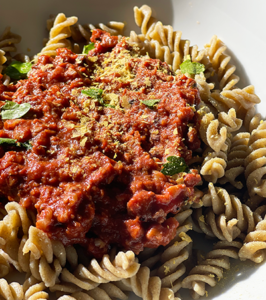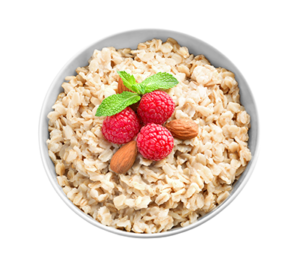
 As your friendly neighborhood registered dietitian nutritionist, diabetes educator and type one diabetes buddy, I couldn’t possibly write this post without saying Happy National Diabetes Awareness Month! While the intent of the month is to bring awareness to diabetes and what it means to be living with the illness, I want to take this time to celebrate our community.
As your friendly neighborhood registered dietitian nutritionist, diabetes educator and type one diabetes buddy, I couldn’t possibly write this post without saying Happy National Diabetes Awareness Month! While the intent of the month is to bring awareness to diabetes and what it means to be living with the illness, I want to take this time to celebrate our community.
Whether you’re someone living with diabetes or a caregiver of someone with diabetes—give yourself a pat on the back. It isn’t easy living with this chronic illness, yet we wake up every day to face it and whatever else comes along our way. In case someone hasn’t said it lately, you’re doing a fantastic job!
With that being said, let’s dive deeper into some foods that are notorious for causing blood sugar spikes. I like to start off discussions like these with a few disclaimers.
First things first, this post is not meant to be a substitute for medical advice. Please contact your own healthcare provider to obtain personalized care. Second, if you are someone who utilizes medication to manage your diabetes and are struggling with keeping numbers in range, taking your medication as prescribed, carb counting to the best of your ability, and using more advanced insulin dosing strategies to cover your meals (for those on insulin), you may need to discuss this with your provider. At times, there can be a lot of blame and emphasis placed on the food we are consuming when it could potentially be a medication mismatch. Lastly, everyone is different. My diabetes is not your diabetes and vice versa. Some foods may just impact you differently!
In previous blog posts, I’ve mentioned the benefits of fruits and vegetables for people living with diabetes. By simply adding more of these to your plate at mealtimes (of course with taking the carbohydrate amounts into account for those on insulin), you can help improve the way your body handles some of the more challenging foods. Alternatively, by adding some of the foods that help keep your blood sugars in range like fruits and starchy vegetables, you can help transform the way your body handles these foods as well.
Sometimes when we think of planning meals, an emphasis is placed on taking away when it really should be placed on adding nourishing and nutrient dense foods to some of the dishes we already know and love. That being said, let’s jump in and take a look at some of the more challenging foods we encounter as people living with diabetes and ways to make them a little easier to manage!
Pizza
![]() If you were to ask any person living with diabetes what food gives them the most trouble, 9 times out of 10 they would likely reply with pizza!
If you were to ask any person living with diabetes what food gives them the most trouble, 9 times out of 10 they would likely reply with pizza!
Even though pizza has all of the pieces of the puzzle “necessary” to promote balanced blood sugars, like protein and fat, it has carbohydrates and fats to make it challenging.
Even still, pizza is not off limits for people living with diabetes.
When choosing your slice, take into consideration things like crust styles. By choosing a thinner crust, you’re able to reduce the amount of carbohydrates, which can reduce impact on blood sugars and minimize those pesky spikes that occur hours later due to the high fat content delaying digestion.
Another alternative that can be used are crusts made with alternative flours, such as cauliflower and broccoli, as these ideally would have a lower glycemic impact and higher amount of fiber to help with blood sugar stabilization. While these could be great solutions, there are several things to take into consideration.
Alternative crusts can have just as much carbohydrates from being mixed with higher glycemic flours like rice flour and even more saturated fats from the cheese that is used to bind the crust together. They also tend to have more sodium due to having extra cheese in the crust in addition to the traditional pizza toppings like pepperoni, olives and cheese, which could cause increased blood pressure levels and dehydration (which can negatively impact blood sugars). Like with traditional pizza, you still have to be mindful of portion sizes when consuming these types of pizzas.
Pizza can have multiple sources of high fat proteins that can further delay the pizza’s digestion. Reducing the amount of these by adding more veggies to your slice or choosing leaner meats can help make the blood sugar response more ideal. Choose options such as onions, peppers, garlic, mushrooms, spinach, tomatoes and arugula as “pickled” items like olives, pepperoncini peppers and artichokes will have more sodium.
When consuming pizza, increasing movement post meals can not only help your body use the insulin you are producing or injecting better, but can also help speed along digestion. If you have not discussed any advanced dosing strategies with your provider, I strongly recommend doing so. A strategy like using an extended bolus feature would allow you to take a portion of your insulin prior to the meal to cover the initial spike, but also allows you to take the rest of your insulin slowly over a certain amount of time.
Pasta
 As a diabetes care and education specialist, I would say pasta is one of the main concerns from my clients and rightfully so!
As a diabetes care and education specialist, I would say pasta is one of the main concerns from my clients and rightfully so!
Typically, pasta dishes can have a lot of carbohydrates due to large portions and less ingredients such as protein, which helps slow down the digestion of the carbohydrates. Nevertheless, pasta is ALSO something that can be enjoyed by people living with diabetes. Like pizza, it’s about identifying the best strategy that works for you and is the most sustainable.
When it comes to vegetable pastas (zucchini and kohlrabi are some of my personal favorites), they can be beneficial to people living with diabetes for several reasons, including the lower carbohydrate and higher fiber. They can also be a great way to lower caloric intake for those focusing on weight management.
While a fantastic swap, it’s important to realize that these are not going to taste like traditional pastas. If you’re someone who doesn’t consume higher amounts of fiber on a regular basis, eating a huge plate of vegetables may cause stomach upset, which can cause some who try it to never try again. A way to fix this can be simply swapping out ⅓-½ of your traditional pasta for a veggie based one or more veggies.
Pastas made from legumes like beans and lentils often have high amounts of fiber and protein. With this being said, there are a few things to remember when it comes to these as well.
-
They don’t taste like traditional pasta. They can often be more dense, which some people may dislike.
-
They still have carbohydrates! As stated in previous posts, carbohydrates aren’t bad, but it is important to be mindful of portion sizes when planning meals as they will have the most impact on blood sugar levels. At times, people equate these alternative versions of foods as “healthier” and increase their portion sizes without being aware that it can still cause blood sugar to spike.
-
These are typically more expensive than traditional pastas.
Traditional pasta was one of the foods I didn’t eat for years post-diagnosis. It wasn’t until my education and the emergence of the technology that we have now, that I was able to revisit pasta. Successful ways to consume traditional pasta are adding more vegetables, lowering the amount of fat oils, butter, cheese sauces and meat sauces and monitoring portion sizes. If you’re dining out, combining these methods with your best dosing and movement strategy can help as well.
And one of my favorite ways to eat plant-based is pasta! You can get creative with your ingredients and make it as simple or complicated as you like. By incorporating a high fiber protein pasta, you are able to further amplify the blood sugar friendly benefits of the veggies.
While this recipe below is definitely intermediate to advanced, you can achieve a similar result by simply sauteing fresh mushrooms and adding them into already prepared store bought pasta sauce.
Download a Plant-Based Meat Sauce & Rotini Recipe (PDF)
Oatmeal
 Oatmeal is often touted as one of the “best” foods for people living with diabetes. It has a high amount of fiber and is a source of prebiotics. Prebiotics act as fuel for our good gut bacteria and have been shown in studies to potentially aid with glycemic control. It is also one of the more common foods that my clients have found challenging.
Oatmeal is often touted as one of the “best” foods for people living with diabetes. It has a high amount of fiber and is a source of prebiotics. Prebiotics act as fuel for our good gut bacteria and have been shown in studies to potentially aid with glycemic control. It is also one of the more common foods that my clients have found challenging.
Similar to the foods mentioned above, the type of oatmeal and how you combine it with other foods determines your blood sugar response. Instant oats are more convenient, but are more processed which results in less fiber. They also can have more added sugar, which combined with lower fiber can lead to a spike in sugars.
Adding things like nuts, seeds, nut butters and protein packed Icelandic and Greek style yogurts can help to slow down digestion and keep you fueled longer than consuming two packets (which will double the carbohydrate). You can also choose an unsweetened or lower sugar instant oatmeal and control the amount of added sugar portion by adding your own dried fruits or fresh fruit.
Choosing less processed oat forms, such as steel cut oats and groats, will have a much higher fiber content than the instant and rolled oat form. These fiber filled types can be cooked or prepared ahead of time and chilled as overnight oats.
Now, you see why these foods are challenging and ways to make them a bit more manageable. Once you’re able to identify the blood sugar raising factors like high fat content, high added sugar content and low fiber content in these foods, you’ll be able to apply these diabetes detective tools to other foods that cause similar responses like desserts and foods when you are dining out.
Be sure to tag @Glooko or myself (@BalancedWithBridgetWood) on Instagram, and use the hashtags, #BetterTogether and #BalancedWithBridgetWood, in all of your blood-sugar-challenging to blood-sugar-balancing meal transformations!
Your Friend in Food,
Bridget Wood, RD, LD, CDCES
MKT-0412





